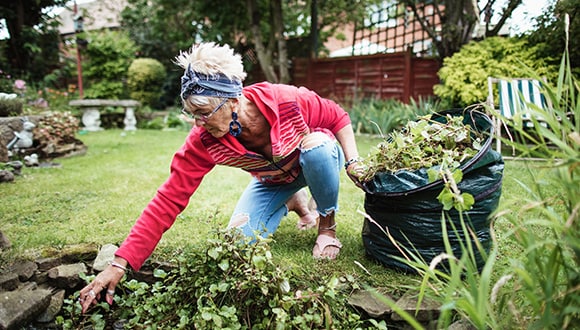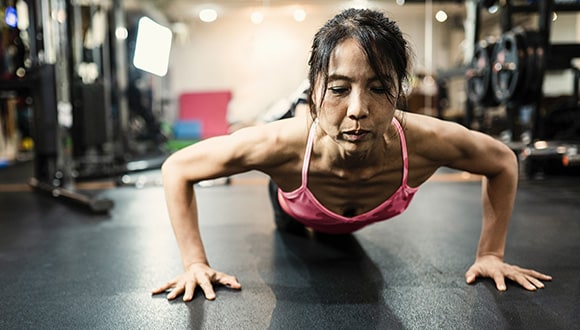Why resistance training is essential for women at every age
Updated February 2023 | 5 min read
Expert contributor Carly Ryan, exercise physiologist
Words by Trudie McConnochie
Resistance training is a key part of staying healthy for women at all stages – but older Aussies aren’t hitting their quota. Here’s how to integrate it into your daily life.
Finding time to exercise can be one of life’s challenges, especially for women. Whether you’re caring for your family, dealing with life admin or have creaky joints and health conditions, resistance training isn’t always top of the list.
A recent survey found over half of all Aussie women aren’t hitting their exercise quota, which is at least 150 minutes of moderate intensity physical activity (or 75 minutes of vigorous activity) each week – or an equal equivalent of both – for adults aged 16 to 84. Those aged 65 and over should aim for at least 30 minutes of moderate intensity physical activity on most, preferably all, days.
As we age, staying active with some kind of resistance training is one of the most important things you can do to prevent illness, maintain a healthy weight, strengthen bones and promote good mental health. About half of age-related physical decline may be due to not moving enough.
“It’s really important for keeping joints healthy,” says exercise physiologist Carly Ryan. “It can also help with increased balance and decreased risk of falls or injury, as well as improved sleep, improved mental health and reduced depression.”
On top of that, research shows resistance training can result in significant improvements in both insulin sensitivity and glucose uptake – good news for those with conditions like diabetes, polycystic ovary syndrome (PCOS) and cardiovascular disease. Resistance training has also been found to reduce various menopausal symptoms (like hot flushes), increase bone density and improve quality of post-menopausal life.
What is resistance training?
Resistance training – also known as strength training – is physical exercise that improves the strength and endurance of your muscles. Carly describes it as “moving your muscles against a force or resistance, stimulating them to get stronger”. It’s particularly important, she says, for women over the age of 65.
“The research is strongly showing that by doing some kind of resistance training, we can slow or stop that natural – or what people consider to be natural – muscle and bone density loss with age,” she says.
This is essential, she adds, as the average woman loses about three to five kilos of lean muscle every decade from middle age. Resistance training is also beneficial for weight loss, balance, sleep and brain function – all important factors as we get older.
So why are women not incorporating enough resistance training into their lives? Carly points to a lack of awareness of the benefits, along with fear that it will cause harm.
“The idea of resistance training can probably be a bit intimidating. A lot of people think resistance training only involves heavy dumbbells or big machines, and that’s just not the case,” says Carly.

What are some examples of resistance training?
Resistance training can be anything from gardening to push-ups – any activity that causes your muscles to contract against an external resistance. The good news, Carly says, is you can make resistance training part of your everyday routine, without an expensive gym membership.
The main ways to work your muscles at home, in the park, in the office or even at the local pool are by using your own body weight, handheld weights or resistance bands. And if you do have a gym membership you can use the free weights and weight machines.
Here are some easy ways to include resistance training in your life:
- heavy gardening and even cleaning the house
- yoga and Pilates
- push-ups, sit-ups and planks
- lifting weights (handheld weights, bottled water/tins or heavy groceries)
- swimming against a jet at your local swimming pool
- climbing the stairs or hill walking (with optional ankle and wrist weights)
- dancing or cycling (with ankle and wrist weights).
Resistance bands are also an effective way of incorporating resistance training into a workout. They work your muscles and core, are versatile, cost effective and easy to use. A pack of bands usually only costs around $10 and they require no set up.

How to get started with resistance training
No matter how old you are, it’s never too late to get into resistance training. Carly recommends two to three resistance training sessions per week, which can be done in 10-minute blocks.
“If you’ve got any concerns or medical conditions, and you don’t know where to start, talk to your GP,” says Carly. “They’ll be able to direct you to an appropriate exercise professional.”
Our partnership with GP2U, an online video GP service, makes it easier for you to access telehealth services and your consultation can take place from your home, or wherever you have internet access. All HCF members with health cover can access a standard GP consultation (up to 10 minutes) for a fee of $50. See hcf.com.au/gp2u for more information.
Simple resistance exercises to do from home
Get started with these three resistance exercises below and remember to start slowly and increase over time. Aim to target most major muscle groups: legs, back, core and arms, and plan to build opportunities for resistance training into your day.
- Sit to stand: Stand in front of a chair, then slowly sit down – don’t drop into the chair – then stand up again. Repeat 10 times. Health wins: Strengthens legs and builds balance.
- Wall push-ups: Place your hands on a wall shoulder-width apart, standing slightly back from the wall. Raise your heels off the floor a little. Keeping your body straight, let your chest move towards the wall, then push back out with your arms. Aim to do two sets of eight to 10 push-ups at a time. Health wins: Strengthens upper body and builds stability.
- Hip raises: Lie on your back on the bed and bend your knees so your feet are flat. Squeeze your tummy in a little and squeeze your bottom, then lift your hips so your shoulders, hips and knees are in a straight line. Aim to hold for 30 seconds or lift up and down a few times as you build up to the full hold. Health wins: Strengthens glutes and core.
Need help improving your diet and fitness?
You can trust HCF to help you be your healthiest self. That’s why we’ve launched The COACH Program®. Delivered by qualified health professionals, this telephone support program is provided by health coaches, at no extra cost for eligible members* with heart conditions or diabetes.
Related articles
How to get strong bones
There’s more to keeping your bones strong than just drinking milk. Here are five surprising ways to boost bone health.
How to lose weight over 50
With a few lifestyle changes, maintaining a healthy weight doesn’t have to be hard as you age, says dietitian and exercise physiologist Caitlin Reid.
IMPORTANT INFORMATION
* To be eligible, members must have a heart-related condition or diabetes and must have had hospital cover that includes heart conditions and vascular system for at least 12 months. Excludes Ambulance Only, Accident Only Basic Cover and Overseas Visitors Health Cover. Clinical eligibility applies.
This communication contains information which is copyright to The Hospitals Contribution Fund of Australia Limited (HCF). It should not be copied, disclosed or distributed without the authority of HCF. Except as required by law, HCF does not represent, warrant and/or guarantee that this communication is free from errors, virus, interception or interference. All reasonable efforts have been taken to ensure the accuracy of material contained on this website. It’s not intended that this website be comprehensive or render advice. HCF members should rely on authoritative advice they seek from qualified practitioners in the health and medical fields as the information provided on this website is general information only and may not be suitable to individual circumstances or health needs. Please check with your health professional before making any dietary, medical or other health decisions as a result of reading this website.